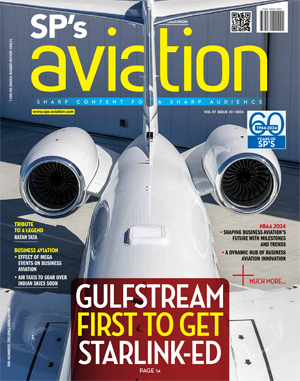INDIAN ARMED FORCES CHIEFS ON OUR RELENTLESS AND FOCUSED PUBLISHING EFFORTS

SP Guide Publications puts forth a well compiled articulation of issues, pursuits and accomplishments of the Indian Army, over the years

"Over the past 60 years, the growth of SP Guide Publications has mirrored the rising stature of Indian Navy. Its well-researched and informative magazines on Defence and Aerospace sector have served to shape an educated opinion of our military personnel, policy makers and the public alike. I wish SP's Publication team continued success, fair winds and following seas in all future endeavour!"

Since, its inception in 1964, SP Guide Publications has consistently demonstrated commitment to high-quality journalism in the aerospace and defence sectors, earning a well-deserved reputation as Asia's largest media house in this domain. I wish SP Guide Publications continued success in its pursuit of excellence.
Operation - Apportioning Airspace

It is important to begin airspace design with the concept of shared use. No one operator type—be it military, airline, aerial work, government, recreation or business aviation—should be allowed sole use of large sectors of a nation’s airspace.
Amixture of air traffic, comprising varying sizes and types, invariably and not before long will call for demarcation and delineation of the competing users. To facilitate this, an equitable airspace system must be developed—not an easy task, as each user group seeks to preserve its hegemony. Competing interests make fairness a near impossibility, as the needs of the varying missions and aircraft types interpose.
The answer is to cleave the available airspace into orderly partitions, with rules applicable to each airspace class that make it more attractive to some users than others. By establishing de facto segregation, safety is enhanced while allowing as much interaction as possible. Fortunately, the performance characteristics of smaller general aviation airplanes, versus those of high performance airline, business and military aircraft, allow the most disparate users to keep well away from each other except when manoeuvring at low altitude during arrivals and departures.
It is important to begin airspace design with the concept of shared use. No one operator type, be it military, airline, aerial work, government, recreation or business aviation, should be allowed to have sole use of large sectors of a nation’s airspace. As a national resource, owned by the people at large, use of the air should be shared, in the best interest of everyone. However, segregation by performance and capability is a reasonable adjunct of partitioning to promote safety.
Operational airspaces of ICAO
How much territory should be allotted when establishing the boundaries of an airspace type? Only the amount needed for the task, often with a compromise to accommodate competing interests next door. Bear in mind that this includes vertical limits, as well as lateral ones.
Airspace apportionments generally fall into two major categories—operational and restrictive. Operational airspace classes are most often designated by letter codes, established by the International Civil Aviation Organization (ICAO) guidelines, beginning with the most demanding, Class A, and descending to the least authoritarian, Class G. Other restrictive airspaces are established for specific needs, such as national security, hazard avoidance, military use and border crossing.
ICAO airspaces, as defined in Annex 11, are not uniformly applied, varying in implementation from country to country. However, for pilots traveling internationally, any use of ICAO standard airspace designators makes life simpler. We will discuss each airspace type in the following paragraphs.
Class A, or Alpha, airspace may be used only by aircraft operating under instrument flight rules, with all flights under positive air traffic control. While this sounds like the safest option, it strictly limits the amount of traffic that can be handled in a given volume of airspace, even with radar control, because instrument flight rules require large in-trail spacing (typically 5 miles) and 1,000 feet of vertical separation. If radar surveillance is lacking, the application of time-and-reporting separation requires even more space. Class A is best restricted to mid-to-high altitude en route sectors, which are normally flown under IFR in any case.
Flight in Class B airspace is more convenient than Class A, because operation under VFR is permitted, although IFR in-trail separation is maintained between all aircraft, under positive ATC supervision. Vertical separation between participating VFR aircraft and an IFR aircraft can be as little as 500 feet, which increases capacity of the airspace. Aircraft flown VFR in the Class B airspace need not be IFR-capable, nor do pilots have to be instrument rated or current. Class B is primarily intended for enhancing safety of the airspace around busy airports used by scheduled airliners and aircraft of similar performance.
For less active airports still requiring a measure of added safety, Class C airspace volume is typically slightly smaller than Class B, both in height and lateral distance, Most importantly, IFR in-trail separation standards are not used in Class C, but only the separation provided by radar target spacing, supplemented by pilot confirmation that the preceding traffic is in sight. Unlike Class B, pilots of aircraft operating under VFR are not provided separation service from other VFR flights. Responsibility for avoiding conflicts under VFR is left to the pilot. This greatly increases the controller’s flexibility when handling aircraft of disparate airspeeds; VFR traffic, generally slower and less route restricted, can be routed to lessbusy airspace within Class C.





